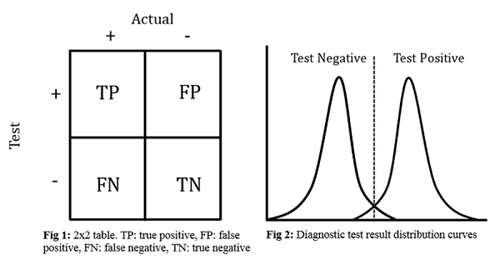
Last time we discussed some high-yield areas to focus on when reviewing biochemistry for Step 1. Like biochemistry, biostatistics is a frequently neglected but often tested subject area. In my opinion, biostats are perceived to be a low-yield topic relative to the amount of studying required for adequate preparation because it is a fundamentally different discipline from the bulk of Step 1 (ie pathophys, pharmacology, etc). Instead of focusing on the individual patient, biostatistics considers large populations, and thus employs different concepts, terminology, and (oh no!) math. Here we will discuss some essentials of biostatistics for Step 1.
It is important that examinees be comfortable deriving information using both 2x2 tables and distribution curves shown below. We will briefly review concepts related to these two diagrams:  Sensitivity, specificity, positive predictive value, and negative predictive value are four indispensible terms that can be calculated from Fig 1. They are defined as follows:
Sensitivity, specificity, positive predictive value, and negative predictive value are four indispensible terms that can be calculated from Fig 1. They are defined as follows:
Sensitivity: TP/(TP+FN)
Specificity: TN/(TN+FP)
Positive predictive value: TP/(TP+FP)
Negative predictive value: TN/(TN+FN)
Examinees should know these formulas and more importantly, be able to apply the concepts of sensitivity and specificity in a problem involving a diagnostic test as in Fig 2. In Fig 2, note how sensitivity/specificity and false positive/false negative rate values change as the vertical dotted line shifts left or right. Comprehensive material review is beyond the scope of these posts, but we will go through a typical Step 1 problem that involves concepts illustrated in Fig 2 next time to highlight their importance. For now, recall that when the dotted line shifts left, sensitivity increases and when the line shifts right, specificity increases.
A large percentage of biostatistics questions on Step 1 will involve concepts derived from the above figures. While reviewing biostatistics, other terms and formulas (incidence/prevalence, absolute/relative risk reduction, number needed to treat/harm, etc.) will be particularly high-yield as well.
Relative to physiology, pharmacology, and pathophysiology, biostatistics questions are relatively uncommon, but they are guaranteed to appear on Step 1. When they do, they should be “gimmes”. Remember, biostats are often ‘1-step’ problems, so make sure you are able to apply concepts and be careful with calculations.
- 23 Mar 2015
- USMLE
